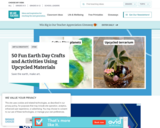
30 crafts you can do at home or school with recycled materials. Get Creative!
- Subject:
- Arts Education
- Visual Arts
- Material Type:
- Activity/Lab
- Author:
- Jessica Mcfadden
- Posted Jessica Mcfadden
- Date Added:
- 06/01/2020

30 crafts you can do at home or school with recycled materials. Get Creative!

This collection of lesson plans investigates ways artists address political and social issues through their
practice. By carefully examining three works of art from the Chazen’s collection, students will be able
to consider what activism is and how it relates to them and their community. The artwork used in the
curriculum ranges from photographs of schoolchildren exploring their use of language (Ewald) to a
silhouette narrative examining our nation’s fraught history with racism (Walker). The artwork is diverse
in medium, subject, tone, and message. However, several universal themes are present.
The artwork in this collection connects to activism through:
• Addressing histories of oppression
• Considering issues of representation
• Bringing awareness to social and political issues

In this art history video discussion Beth Harris and Steven Zucker look at Albrecht Durer's "Self-Portrait, 1500." (Alte Pinakothek, Munich).

This art history video examines the "Alexander Mosaic" c. 100 B.C.E., tessera mosaic from the House of the Faun, Pompeii. This Roman floor mosaic may be based on a lost Hellenistic painting by Philoxenos of Eretria, The Battle of Issus, c. 315 B.C.E.). Museo Archeologico Nazionale, Naples.

This site explores the elements of art and principles of design with videos, examples and lessons.
The elements and principles of design are the building blocks used to create a work of art.
Elements of Art are the visual "tools" that artists use to create an art work - they are what makes up an image or an art object: line, shape/form, value, color, space, and texture.
Principles of Design are the ways artists use the Elements of Art in an artwork - this is "what we do with the Elements" - how we arrange them, how we balance them, what is being emphasized, etc. The principles are: balance, contrast, repetition, emphasis, and unity.
Be sure to check out Art 2 - Lesson plans for intermediate Art program @ https://resourcebank.ca/courses/art-1-lesson-plans-for-beginner-art-program

Art 2 offers a two semester program:
Semester 1
Focus on drawing skills:
creative drawings, shading techniques review and practice, pen and graphite drawings, texture shading, colored pencils and oil pastels techniques, design stylizing techniques, non-traditional art media, mix-media, introduction to watercolor pencils, watercolor techniques, etc.
Semester 2
Focus on drawing, painting and printing media:
unusual painting media, creative designs - practice eye-hand coordination, pen and ink drawings, pattern values and creative application, introduction to silk screen printing, optical illusions and OpArt - review perspective, collages and acrylic paintings, composition and colors in Art.
Be sure to check out Art 1 - Lesson plans for intermediate Art program @ https://resourcebank.ca/courses/art-1-lesson-plans-for-beginner-art-program-2
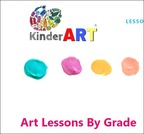
Here you can browse through art lesson plans by age or grade, from Preschool through High School.
The site includes a "What you can expect" of students artists at each age level.
At KinderArt "Our mission is to create and provide art lesson plans that parents and teachers can use in their home and school classrooms. We aim to offer ideas that make use of readily available materials that won't break the bank."
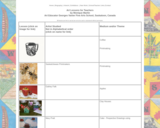
Art Lessons for Teachers
by Monique Martin
Art Educator Georges Vanier Fine Arts School, Saskatoon, Canada
Includes: printmaking, sculpture, perspective drawing, colours, mixed media, chair design, clay, architecture, cultural art, drawing, painting, quilting, and much more!

This collection of art videos will support teachers and students in their quest to learn more about art.
Videos include: Matisse, Chagall, Michelangelo, pointillism, Britto, Chinese Dragon, Dali, Pollock, Tin Art, Kindness Rocks, Landscapes, Fashion Design, Collaborative Portraits, Zentangle, Howard, Dhurrie Rug, Magritte.
There are great ideas for lessons here, information about famous artists and great individual or collaborative projects.

Students will learn about axial movements and locomotor movements by discussing dancers depicted in a drawing and photograph. They will then practice combining axial and locomotor movements. They will describe how artists depict a dancer's motion in drawing and photography. They will also analyze how an artist creates movement and emphasis through contrast, composition, and leading lines, and then experiment with photography to capture motion in dance.

"Many artists create work that intersects with political activism and social justice causes. Throughout history, art has been used as an accessible tool for communication, raising awareness about social issues and affecting positive change. This video collection will introduce students to artists who create work that inspires dialogue about problems faced by communities around the world, and will provide inspiration for classroom projects with a social, public or political purpose."

Art tutorials on various art mediums and art by subject matter.
Includes paint of all kinds, pencil, pastel, mixed media and more.

Teachers can search their database for lesson ideas and art history assignments.

This site offers visual and performing art lessons from kindergarten through high school. Many of the lessons can be integrated into core subjects such as Math, Language Arts, Science, or Social Studies. Opportunities for creativity are some of the building blocks of child development and concept acquisition. Lessons are categorized by grade for easy retrieval.
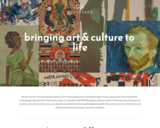
Leading museums share their collections through virtual, augmented and mix reality.
Bringing the arts to life through virtual, augmented and mixed reality, Boulevard is reshaping the landscape of storytelling and revolutionizing the way the world looks at art and culture.
The "Educate" and "Experiences" tabs are a great place to start.
There are full lessons in here under "Educate"!

The AGO’s collection is searchable on their website, but some exhibits stand out more than others.
One gem on the website right now is The Boxwood Project, which contains countless photos of exquisitely tiny gothic carvings, accompanied by not just one scientific analysis showing how researchers figured out how the beads were made, but numerous essays on the topic.
Another feature is an interactive website compiling around 3,000 photographs taken by Henryk Rozencwaijg-Ross of the Jewish ghetto in a Polish city during the Holocaust. Visitors to the webpage are encouraged to use the “Build My Collection” function to curate their own exhibit out of the photographs and share it with others.

In this lesson, students will explore how visual arts can be a tool to advance social justice and cultural change. Students will use a critical media literacy framework to closely examine the 1956 Gordon Parks Life magazine photo essay, “The Restraints: Open and Hidden,” and explore other unpublished photographs Parks took during
this assignment. Students will then explore how current artists such as Devin Allen continue to be inspired by Parks’ work to illuminate injustices through the visual image. Students will see the power of visual art to break down barriers of understanding, bring individuals closer to injustices occurring in their communities, and solidify the historical record for future generations.
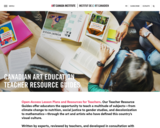
Canadian art is a door to learning about a wide range of subjects.
The Art Canada Institute teacher resource guides presented here offer students the opportunity to study a multitude of subjects—from environmental awareness to activism, social justice to gender studies, politics to computer science (to name a few)—through the art and artists who have defined this country’s visual culture.
Following our provinces’ education curricula, the teacher resource guides provide multidisciplinary learning activities that reveal how Canadian art powerfully reflects our world so we can better understand it.
Activities for K-12!

« La chaîne éducative Cinéma autochtone vise à engager les apprenants dans des discussions sur l’histoire coloniale du Canada et son impact sur les communautés autochtones. Nous vous invitons à découvrir notre collection de films réalisés par des cinéastes autochtones et par des gens qui sont leurs alliés. »
Accédez à de ressources pédagogiques connexes en utilisant votre adresse courriel scolaire pour vous connecter à la plateforme ONF « CAMPUS » : https://www.onf.ca/campus-canada/#campus-subscription-section
**Visionnez toujours les films avant de les montrer aux élèves - cette collection n'est pas nécessairement destinée aux enfants.**

The importance of family is prominent throughout the works, The vibrant colours represents the joy of life, it is meant to inspire hope, success, and happiness. These paintings are a tribute to my late mother who was my guide throughout my life, my late Grandmother for her strength in cultural beliefs and traditions, and my children for the inspiration they give me, Meegwetch.
- Kevin Peeace